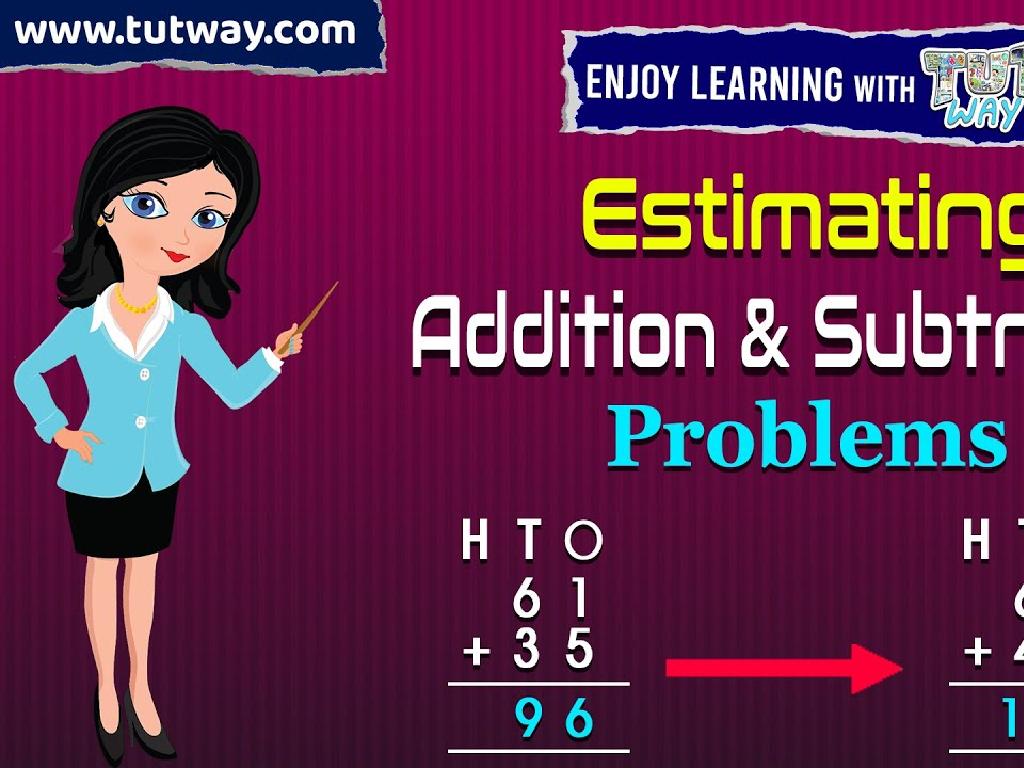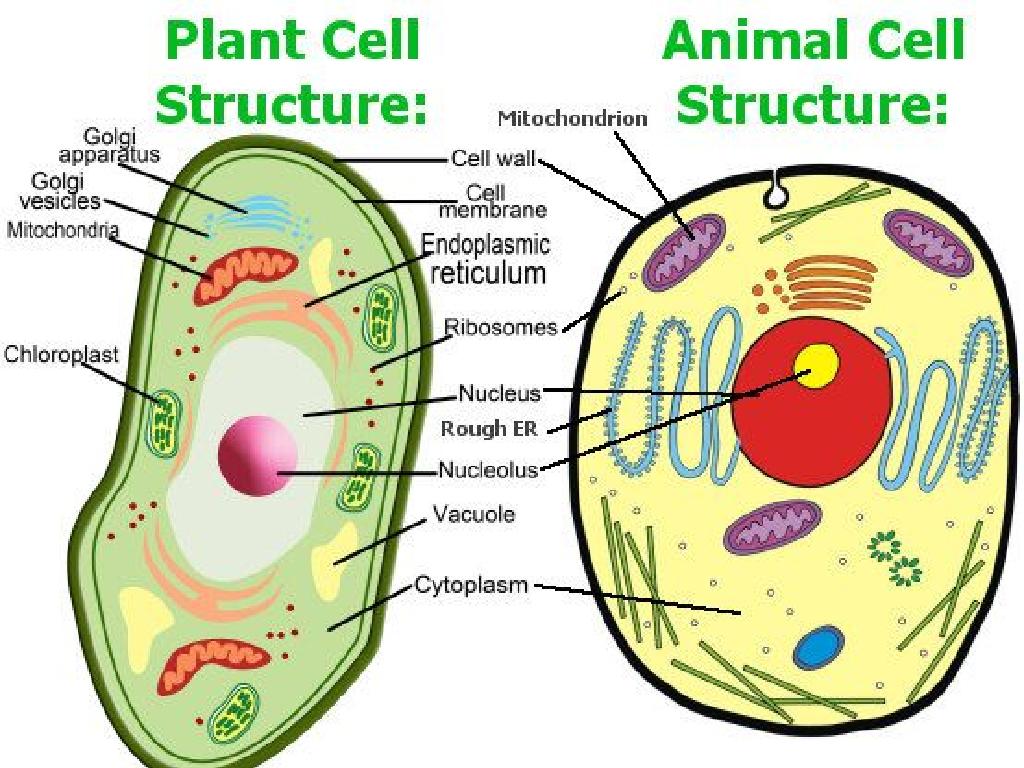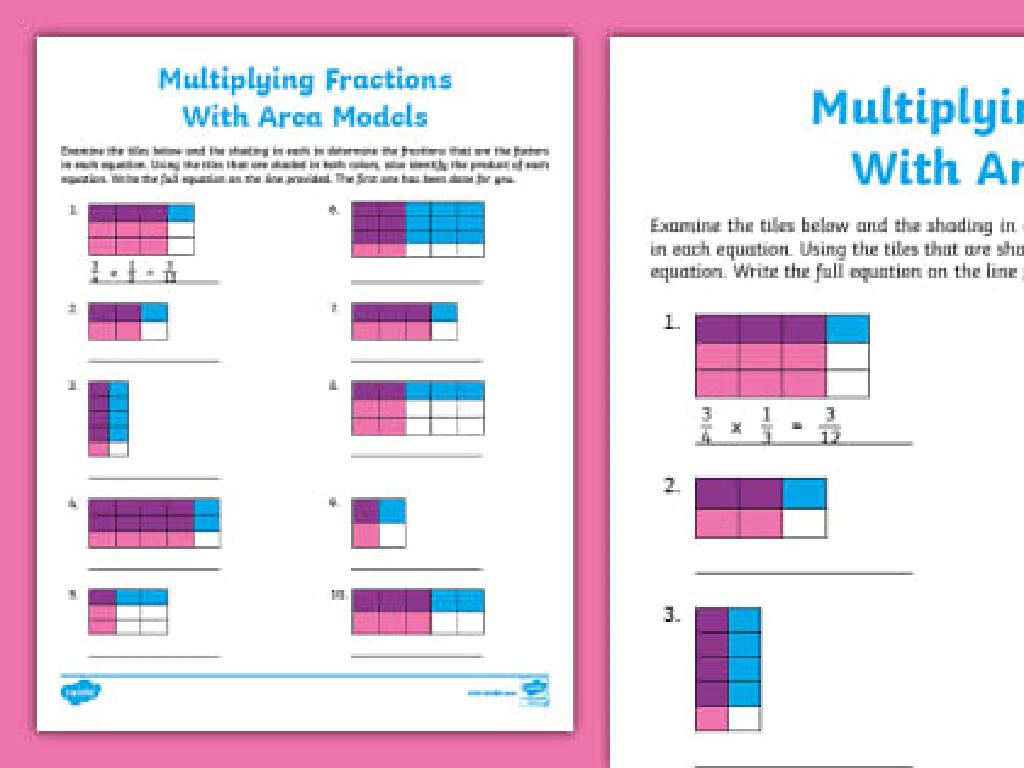Find A Value Using Two-Variable Equations
Subject: Math
Grade: Sixth grade
Topic: Two-Variable Equations
Please LOG IN to download the presentation. Access is available to registered users only.
View More Content
Finding Values in Two-Variable Equations
– Understanding two-variable equations
– Equations with two variables represent a relationship between pairs of values.
– Real-world two-variable situations
– Examples: budgeting with income and expenses, or distance vs. time in travel.
– Today’s goal: solving for a value
– Learn to isolate one variable and solve for the other.
– Practice with example equations
– Use sample problems to apply what we’ve learned.
|
This slide introduces students to the concept of two-variable equations, which are fundamental in understanding how different quantities relate to each other. Real-life examples, such as managing a budget or calculating travel time, make the concept relatable. The goal for today’s lesson is to equip students with the skills to find the value of one variable when given the other. To achieve this, we will practice with example equations, gradually increasing in complexity. Encourage students to think of other areas where two-variable equations might apply, fostering a connection between math and everyday life.
Exploring Two-Variable Equations
– Define two-variable equation
– An equation with two different variables, like x and y
– Examples of equations
– For instance, x + y = 10 or 2x – 3y = 5
– Variables as unknowns
– Variables x and y stand for numbers we need to discover
– Solving for variable values
– Use substitution or elimination methods to find values of x and y
|
This slide introduces the concept of two-variable equations to sixth-grade students. Begin with the definition, explaining that these equations involve two different variables, typically represented by x and y. Provide clear examples such as x + y = 10 and 2x – 3y = 5 to illustrate the concept. Emphasize that variables represent unknown values and our goal is to find these values. Conclude by briefly mentioning the methods of substitution and elimination, which will be explored in subsequent lessons to solve these types of equations. Encourage students to think of variables as placeholders for numbers that we are trying to find through mathematical operations.
Parts of a Two-Variable Equation
– Identify variables x and y
– Variables are symbols that represent numbers
– Understand coefficients
– Coefficients are numbers that multiply variables
– Recognize constants
– Constants are fixed numbers, not multiplied by variables
– Solve for a value
– Use substitution or elimination methods to find values
|
This slide introduces students to the fundamental components of two-variable equations. Variables, usually represented by x and y, are placeholders for numbers we want to find. Coefficients are the numbers that multiply these variables and can affect the solution of the equation. Constants are numbers that stand alone and do not change. Understanding these parts is crucial for solving equations. In class, we will practice identifying these components within different equations and use methods like substitution or elimination to solve for unknown values. Encourage students to work through examples and to ask questions if they’re unsure about how to identify each part of the equation.
Solving Two-Variable Equations: Substitution
– Understanding Substitution
– Substitution is replacing a variable with its value
– Example: x + y = 10, find y when x = 3
– If x is 3, what does y have to be for the sum to be 10?
– Substitute x with 3 in the equation
– Replacing x with 3 gives us 3 + y = 10
– Solve the new equation for y
– Subtract 3 from both sides to find y = 7
|
This slide introduces the concept of substitution in solving two-variable equations, a fundamental skill in algebra. Substitution involves replacing one variable with its given value to find the other variable. Start with a simple example where x is given, and students must find y. Explain step-by-step how to replace x with its value in the equation and then solve for y. After substituting x with 3, we get a simple one-variable equation, 3 + y = 10, which can be solved by isolating y. This gives us y = 7. Encourage students to practice with different values and equations to become comfortable with the substitution method.
Solving Two-Variable Equations: Elimination Method
– Understanding Elimination
– A method to solve systems by removing one variable
– Example: 2x + y = 10, x – y = 2
– Add 2x + y = 10 and x – y = 2 to eliminate y
– Add/subtract to remove a variable
– Adding equations: 3x = 12, then x = 4
– Solve for the remaining variable
– Substitute x in one equation to find y
|
The elimination method is a technique for solving systems of two-variable equations by adding or subtracting the equations in order to eliminate one of the variables. For example, with the system 2x + y = 10 and x – y = 2, adding the two equations results in 3x = 12, which simplifies to x = 4. Once x is found, substitute it back into either original equation to find the value of y. This method is particularly useful when the coefficients of one of the variables are opposites or can be easily made opposites. Encourage students to practice this method with various systems to become comfortable with the process of elimination and substitution.
Graphical Representation of Two-Variable Equations
– Plotting equations on a graph
– Intersection point as the solution
The solution is where two lines cross on the graph.
– Example: x + y = 10 and x – y = 2
Plot both equations and look for where they cross.
– Finding the intersection point
Use graphing to visually solve the equations.
|
This slide introduces students to the concept of finding the solution to two-variable equations through graphical representation. Start by explaining how each linear equation can be represented as a line on a graph. Then, illustrate that the point where the two lines intersect represents the solution to both equations. Use the example provided to show how to plot both equations on the same graph and determine their intersection point. Encourage students to practice this method by plotting more equations and finding their intersection points. This visual approach helps students understand the concept of simultaneous solutions in a tangible way.
Practice Problems: Two-Variable Equations
– Solve for y: x + y = 12, x = 7
– Substitute x with 7, what is y?
– Find y: 2x – 3y = 6, x = 4
– Put x as 4 in the equation, solve for y
|
This slide is designed to provide students with practice on solving two-variable equations. The first problem is straightforward substitution, where students will replace x with 7 in the equation x + y = 12 and solve for y. The second problem requires students to substitute x with 4 in the equation 2x – 3y = 6 and then solve for y. These problems are meant to reinforce the concept of substitution in two-variable equations. Encourage students to work through these problems step by step, and remind them to perform inverse operations to isolate the variable y. After solving, discuss the solutions as a class to ensure understanding. Provide additional similar problems for students who finish early or need extra practice.
Class Activity: Equation Treasure Hunt
– Pair up and solve equations
– Each answer reveals the next clue
– Solve all to find the treasure
– First pair to finish wins!
|
This interactive class activity is designed to engage students in solving two-variable equations by turning the math exercise into a treasure hunt game. Students will work in pairs, fostering collaboration and peer learning. Each pair will receive a set of equations, and each correct answer will provide them with a clue that leads them to the next equation. The clues can be riddles or puzzles that incorporate school subjects or locations. The first pair to correctly solve all the equations and follow the clues will find the ‘treasure,’ which could be a small prize or bonus points. Prepare 4-5 different sets of equations and clues to ensure variety and that each pair has a unique set to solve. This will prevent copying and encourage all students to participate actively.
Conclusion & Homework: Mastering Two-Variable Equations
– Recap: Solving two-variable equations
– Practice is key to mastery
Like sports or music, math skills improve with regular practice.
– Homework: Solve 5 equations
Use different values for variables x and y in equations.
– Share solutions next class
Be prepared to discuss how you found the solutions.
|
This slide wraps up the lesson on two-variable equations and emphasizes the importance of practice for mastery. The homework assignment is designed to reinforce the day’s learning by providing students with additional practice. Encourage students to try different strategies they’ve learned to solve the equations and remind them that making mistakes is a part of the learning process. For the next class, plan a discussion where students can share their solutions and the methods they used, fostering a collaborative learning environment.






